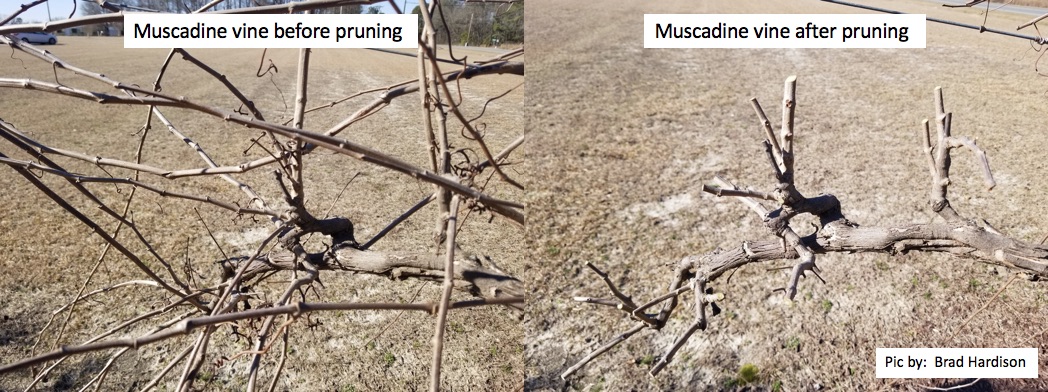From the Vine: Grapes
go.ncsu.edu/readext?917473
en Español / em Português
El inglés es el idioma de control de esta página. En la medida en que haya algún conflicto entre la traducción al inglés y la traducción, el inglés prevalece.
Al hacer clic en el enlace de traducción se activa un servicio de traducción gratuito para convertir la página al español. Al igual que con cualquier traducción por Internet, la conversión no es sensible al contexto y puede que no traduzca el texto en su significado original. NC State Extension no garantiza la exactitud del texto traducido. Por favor, tenga en cuenta que algunas aplicaciones y/o servicios pueden no funcionar como se espera cuando se traducen.
Português
Inglês é o idioma de controle desta página. Na medida que haja algum conflito entre o texto original em Inglês e a tradução, o Inglês prevalece.
Ao clicar no link de tradução, um serviço gratuito de tradução será ativado para converter a página para o Português. Como em qualquer tradução pela internet, a conversão não é sensivel ao contexto e pode não ocorrer a tradução para o significado orginal. O serviço de Extensão da Carolina do Norte (NC State Extension) não garante a exatidão do texto traduzido. Por favor, observe que algumas funções ou serviços podem não funcionar como esperado após a tradução.
English
English is the controlling language of this page. To the extent there is any conflict between the English text and the translation, English controls.
Clicking on the translation link activates a free translation service to convert the page to Spanish. As with any Internet translation, the conversion is not context-sensitive and may not translate the text to its original meaning. NC State Extension does not guarantee the accuracy of the translated text. Please note that some applications and/or services may not function as expected when translated.
Collapse ▲If you would like to add edibles to your landscape without having to work in the yard every weekend, you may want to think about muscadine grapes. Muscadine grapes are native to our area, are well adapted to Sampson County, and are relatively pest free. With a little pruning, fertilization, and observations, you can grow a relatively good crop of grapes and enjoy your harvest in late summer.
Muscadines can be grown for fresh eating, making jellies and jams, or for juice or wine. The variety selection is dependent on the end use because the best grapes for eating aren’t the best for wine making and vice-versa. Fresh eating varieties include Supreme, Paulk, Triumph, Tara, and Fry. Supreme and Fry are female vines which means they won’t produce fruit unless they have a pollinizer vine nearby. Luckily, Paulk, Triumph, and Tara are self-fertile and can be used as a pollinizer. Wine or juice varieties include Carlos, Noble, and Magnolia.
Once you decide on an end use and a variety, then select a site that has full sun and is at least 50’ from tree lines. Take a soil test and make sure that your pH is near 6.5. Trellis your grapes on a single wire trellis 5-6 feet above the ground and keep the area under the trellis weed free. Fertilize according to the vines age. Apply ¼ pound of 6-6-18 fertilizer per vine after planting and 4 weeks later in year one. Supplement with 1 cup of 15.5-0-0 during the second application of fertilizer. In year two, increase the fertilizer to ½ pound per vine and supplement again with the same rate of 15.5-0-0. In year three, the vine is considered mature. Mature vines need 2-3 pounds of 6-6-18 in March and June. Do not fertilizer any vines after July 4th.
Grapes need pruning in January and/or February. Prune vines back to 1-2 buds on last year’s growth. Remove any weak wood that is smaller diameter than a #2 pencil and repeat every year.
The biggest issue with grapes is the failure to prune. Mature vines left unpruned can become a tangled mess of unproductive wood which causes less yield and smaller fruit. Many people get scared when pruning grapes because you remove a lot of growth off the vines, and leave what many describe as a plant skeleton. Grapes produce a lot of new growth each year, so don’t be afraid if the removed wood begins to make a big pile.
Another issue with grapes is that female vines are planted and there is no pollinizer vine to pollinate the flowers, resulting in no fruit. Varieties such as Supreme, Fry, and Darlene are female varieties that must have a pollinizer vine planted within 100’. I have seen several cases of homeowner vines suddenly stop producing grapes because the pollinizer vine had been removed.
The last major issue for grapes is herbicide injury. Grapes are not tolerant to any herbicides sprayed near them. Make sure you or your landscape company leaves a large buffer when spraying your lawn for weeds. Drift and root uptake can severely affect grapes if they come in contact with herbicides.
You can find more information on growing grapes in the home landscape from NC State Extension.




